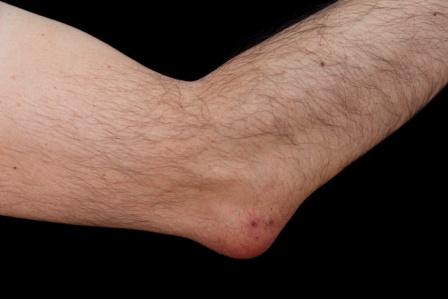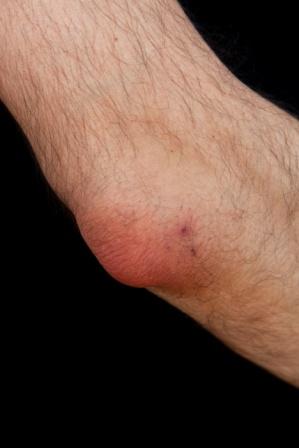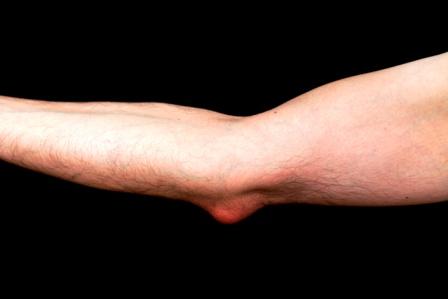Student’s Elbow: Olecranon Bursitis Causes, Symptoms, Treatment
Article by Dr Raghuram Y.S. MD (Ay)
Students elbow is a painful swelling occurring around the bony projection (olecranon process) behind the elbow joint, commonly occurs in students. This is caused due to constant pressure on that bony part of elbow. The students are used to rest their elbow constantly on their writing tables. This exerts a constant pressure on the elbow leading to swelling and inflammation.
Olecranon bursitis is the medical term of Student’s Elbow.

Table of Contents
Olecranon Bursitis
What is Olecranon Bursitis or Students Elbow?
Olecranon Bursitis is an inflammation and swelling occurring behind the elbow. It is characterized by pain, swelling and redness around the elbow joint, mainly the olecranon process.
Olecranon Bursitis or Student’s elbow is basically caused due to the inflammation of the elbow’s bursa (bursa=fluid filled sac).
It occurs due to major injury of the elbow or due to repeated minor injuries. It can also occur due to leaning of the point of elbow against hard surface or repeated movements at the elbow.
Students elbow clears on its own and many times it doesn’t need a treatment or medication, especially when the swelling and inflammation are of a smaller scale.
Treatment may be needed in some cases to reduce the inflammation and clear the fluids which have accumulated around the joint.
Synonyms
Other names of Students Elbow:
Olecranon Bursitis
Smiles Elbow
Elbow Bump
Popeye Elbow
Baker’s Elbow
Gamer’s Elbow
Plumber’s Elbow
Miner’s Elbow
Related terms:
Olecranon process – The forearm (part of upper limb between elbow and wrist joint) is made up of 2 long bones namely Radius (located towards the thumb side) and Ulna (located towards the little finger side). Olecranon process is the top (upper) part of ulna. It is the bony projection forming the tip behind the elbow joint. When you flex (bend) your elbow, you can feel this bony prominence. This is the part on which we rest our elbow or we lean on the olecranon.

Olecranon Bursa – is a small sac or cavity that contains a small amount of fluid. This sac is present behind (over) the olecranon process of ulna. The bursa separates this process from the skin. These sacs help in easy movement of bones and provide free space. The fluid helps in lubrication. The fluid is similar to the fluid present in the joints (synovial fluid).
Olecranon Bursitis
Inflammation of the olecranon bursa is called Olecranon bursitis. Since it more commonly occurs in students it is also called Student’s Elbow. Inflammation leads to swelling around the olecranon process. Extra fluid accumulation also occurs in due course of time.
Pathogenesis
How it happens?
As a reaction to the injury, the lining of the bursa becomes inflamed. It then secretes a much greater (than normal) quantity of fluid into the cavity of the bursa. From here, the fluid cannot go anywhere. This causes inflation of the bursa, producing a swelling over the proximal end of the ulna which is usually inflamed and tender to touch.
Symptoms
Swelling – Thickness and swelling on the back of the elbow. Sometimes it is so large that it restricts motion at the elbow joint. The bursa may be filled with fluid and it looks like a small soft ball, just like a cyst. The bursitis is painless or is associated with mild pain when the bursa is not infected or associated with arthritis.
Pain – originates in elbow joint, mild to severe in nature (depends on nature of inflammation), can spread to the rest of the arm, generally associated with infected bursitis (septic olecranon bursitis). A bursitis associated with arthritis may not be painful itself. Symptoms associated with arthritis such as joint pains will be evident when arthritis is associated.

Redness and warmth of the joint – if the bursa is infected (septic bursitis)
Drainage of pus – if the infected bursa opens up spontaneously, the pus inside it will drain out
Causes
Single major injury – Hard blow to the tip of the elbow, as striking against the wall
Mild but Repeated minor injuries (most common cause) – like repeated leaning on the point of elbow on a hard surface will cause lot of friction and repeated mild injury over the olecranon. Example, students who study whilst leaning on their elbows on a desk (Student’s Elbow)
Job or hobby involving repetitive movement – example, tennis, golf or repetitive computer work involving leaning on one’s elbow
Jobs involving crawling a lot using elbows (Miner’s elbow, Plumber’s Elbow)
Arthritis – one or more bursae may become inflamed as a part of a generalized arthritis (Most cases of olecranon bursitis are not associated with arthritis)
Infection of the bursa – occurs when there is a cut in the skin over the bursa which allows entry of germs (bacteria)
Unknown (idiopathic) – in many cases the cause of bursitis is not known, they may have occurred due to mild injuries in the past which has been forgotten by the patient
Possibility of developing the condition is more common with progression of age, more common towards old age.
Women tend to develop bursitis more than men which according to researchers is due to hormonal influences and stress which can impact the health of connective tissue
Other causes –
- Sports or work related injuries and trauma
- Accidents that impacts elbow joints
- Sudden movements that pull or strain muscles and joints
- Over-training or overuse of elbow
- High risk activities including gardening, carpentry, shovelling, painting, scrubbing, tennis, golf, skiing, throwing, pitching etc
Risk factors
Risk factors for Bursitis –
Old age
Family history of arthritis
Being overweight or obese
Poor lifestyle that causes inflammation
Diagnosis
Examination – typical student’s elbow can easily be diagnosed by its look, but still it needs to be differentiated from other conditions. Thorough examination and case recording will help.
Scans and blood tests – to rule out other causes of elbow swelling i.e. infection (septic arthritis or bursitis), gout or rheumatoid arthritis etc.
X-ray – to rule out fracture in case history of significant injury is obtained
Differential Diagnosis
Gout and Pseudo-Gout (Crystalline inflammatory arthropathy) – occurs when excess uric acid circulating in the blood stream gets deposited as needle shaped monosodium urate crystals in elbow joint. Excruciating pain and swelling are the main symptoms.
Pseudo-Gout – Like Gout, pseudo-gout occurs when crystals form within the joints. The crystals are formed from a salt called calcium pyrophosphate dehydrate. It causes severe pain and swelling which worsens during night. It typically affects a single joint.
Rheumatoid Arthritis – is the chronic inflammatory disease of the joints which occurs when body’s immune system which normally protects us mistakenly attacks the synovium, the thin membrane that lines the joints. This leads to joint damage, pain, swelling, inflammation, loss of function and disability.
Other conditions:
Olecranon traction osteophyte (with or without avulsion) and Olecranon spur – caused due to repetitive strain to triceps tendon insertion
Infection of elbow joint (septic arthritis) – caused by bacteria that spread through bloodstream and cause infection in the elbow joint. It may be caused by virus or fungi. Common infection is due to N. Gonorrhoea.
Triceps tendinitis or triceps tear – inflammation of the tendon of triceps muscle on the back of the arm or tear in the muscle
Lipoma – benign tumour made up of fat tissue
Fracture of the olecranon process of the ulna
Synovial cyst of the elbow joint
When to seek medical attention?
Most bursitis don’t become very severe or dangerous but it’s possible for certain bursitis to progress to the point of causing complications. If you have intense pain for more than 2-3 weeks or any of the symptoms described below manifest, talk to your doctor.
- A very disabling joint pain that leaves you unable to move
- High amount of swelling, redness, heat, bruising or a rash in the affected area
- Very severe sudden and sharp shooting pains
- Fever
- Loss of appetite, dizziness and fatigue
Treatment
No treatment – Many times Student’s elbow may not need a treatment at all. A small painless thickening or swelling is quiet common. It often clears by itself. If a small amount of fluid is left out once the inflammation has subsided, then this can be left alone.
RICE treatment – Swelling will improve with
(R)est,
(I)ce packs,
(C)ompression like wearing a bandage and
(E)levation i.e. keeping the elbow in a raised position. This is called RICE treatment.
Anti-inflammatory medications – NSAID’s can be given to reduce pain and inflammation
Elbow padding – for symptomatic relief
Aspiration – of excess fluid bursa with a syringe (draining of the bursa) shall be done in severe cases wherein lot of fluid has been accumulated in the bursa so as to restrict movements
Injection – into the bursa of hydrocortisone type medication which helps in relieving inflammation and prevents further accumulation of fluids
Antibiotics – should be used if the bursa is infected
Ultrasound and electrical treatment – have found to be helpful in some patients
Surgery – If the fluid continues to return in spite of multiple draining being done or if the bursa is constantly causing pain to the patient, the bursa should be removed through surgery.
Exercise tips to keep inflammation levels low near susceptible joints (as recommended by The National Institute of Health) –
Take 10 minutes to warm up and stretch before exercise
Use resistance bands or weights to help strengthen the muscles around the joint
Take frequent breaks from repetitive tasks or activities to stretch
Protect your elbows with pads when doing certain contact activities or sports
When working with your hands, playing tennis or golfing, try to increase the gripping surface on tools by using gloves, grip tape or padding
Begin new activities or exercises slowly and with proper form, perhaps considering hiring a trainer at first to help guide you.
Click to Consult Dr Raghuram Y.S. MD (Ayu)








